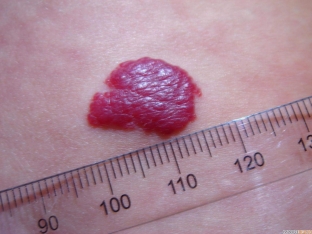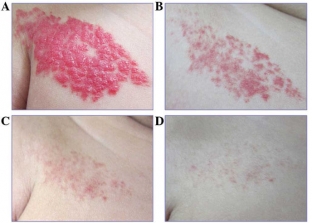About 10% of babies are born with a dark red or bluish spot, which is most often localized in the head area. Such formations are called hemangiomas, i.e. benign vascular tumors. Most often, hemangiomas are congenital, but they can also appear in the first month of a child's life. The size and number of vascular formations vary, as do their behavior – hemangiomas can grow, spontaneously resolve, or retain their original size. Are hemangiomas dangerous in children and should they be removed?
Hemangiomas in children – unpredictable vascular formations
The causes that lead to the appearance of hemangiomas in children are not fully understood. Presumably, the culprits for the appearance of such spots in newborns are a viral infection transferred during pregnancy, medication, or adverse environmental conditions. As a result of exposure to such factors, the normal process of vascular development is disrupted. The most common localization of hemangiomas is the head area, the second place in the frequency of occurrence of such formations – genital area.
Premature babies are most often born with hemangiomas.
It is impossible to predict how the hemangioma will behave. That is why experts recommend monitoring the development of this neoplasm and, if it grows (most intensively during the first 6 months of life), be sure to consult a specialist.
Approximately 7% of the time, i.e. quite rarely, by the age of 5–10 years, vascular tumors spontaneously resolve. Therefore, in some cases, it is advisable to remove hemangiomas in children, especially if they appear in places prone to mechanical damage (in places of friction against clothing). It is important to remember that damage to hemangiomas does not exclude the risk of infection.

Types and characteristics of hemangiomas in children, as well as the frequency of their occurrence
There are four main types of hemangiomas that can occur in children:
- Simple – formations with clear boundaries, mostly with a smooth surface. Such hemangiomas react to pressure with blanching, followed by a gradual restoration of the previous color. This type of hemangiomas is the most common.
- Cavernous – this formation, rising above the skin, has the form of a node. The cavities of this type of hemangiomas are filled with blood, and the surface of the skin on the tubercle often has a bluish tint. If you press on such a hemangioma, it will turn pale and subside, but due to its softness and elasticity, it will soon restore its shape and color.
- Combined – combine the characteristic features of simple and cavernous hemangiomas and are located not only in the skin, but also under it.
- Mixed – in addition to vascular tissue, they contain elements of other tissues, which determine their appearance and consistency.

Is it necessary to remove hemangiomas in children, and what methods are used for this?
Determination of the type and degree of danger of hemangioma – task of a qualified specialist. However, there are some features inherent in hemangiomas in children that cannot be ignored by a professional. They are:
- location of vascular formations on the head and neck;
- localization of hemangiomas in the oral cavity;
- anothetic location of hemangiomas;
- intensive increase in neoplasm in size;
- bleeding complications;
- infection;
- ulceration.
The need to remove hemangiomas in the cases described above is due to complications that can manifest as visual, respiratory and other dysfunctions, as well as infection.
Vascular tumors are also removed if they represent a serious cosmetic defect.
The method of hemangioma removal is selected together with the doctor after an accurate determination of the type of formation, the risks associated with it, the depth and area of growth, and other individual characteristics.
The arsenal of methods used to remove hemangiomas in children includes:
- sclerotherapy;
- cryolysis;
- electrocoagulation;
- radiotherapy;
- laser therapy;
- combination of several methods.
In solving aesthetic and medical problems associated with the appearance of hemangiomas in children, laser therapy has proven to be excellent, which is successfully carried out by specialists from the Clinical Academy of Laser Medicine. For this purpose, the Fotona XP:Max (Slovenia) super-powerful laser system is used, which provides fast, safe and effective treatment.
There are a number of advantages to laser removal of hemangiomas:
- painlessness, which is important when working with children;
- no age limit;
- no scars and burns due to the selective effect of the laser beam;
- possibility of removing large hemangiomas;
- possibility of removing hemangiomas in hard-to-reach places.

The expediency of laser therapy for hemangiomas is determined by the doctor after examining the child. At the Clinical Academy of Laser Medicine, the specialist will carry out all the necessary diagnostic measures and, taking into account the wishes of the parents, will select the safest and most effective method for removing hemangiomas in children.






Add a comment